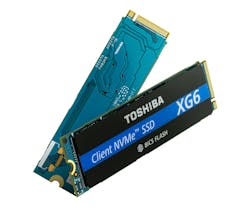The Flash Memory Summit was host to a range of large, high-end storage solutions for the enterprise, but that’s not to say compact embedded options were left out. In fact, just the opposite—for example, there was the announcement of the SD Express specification that brings PCI Express and NVMe to the SD card form factor.
Winbond was showing off its spread of serial flash devices, including the new W25N01JW NAND flash chip that can replace SPI NOR in automotive applications. NAND flash can deliver high capacities and performance. The chip supports an 83-MB/s transfer rate using a Quad Serial Peripheral Interface (QSPI). It employs single-level-cell (SLC) NAND flash storage and complies with the AEC-Q100 standard as well as relevant JEDEC specifications. The automotive-grade chips come in an 8- × 6-mm WSON or TFBGA package.
1. Winbond’s SpiStack (left) is a system-in-package (SIP) that mixes a 1-Gb serial NAND die with a 16-Mb NOR die. The alternative is a pair of chips including a serial NOR (middle) and a serial NAND flash device (right).
Also on display from Winbond was its SpiStack (Fig. 1). The SpiStack is a system-in-package (SIP) that mixes a 1-Gb serial NAND die with a 16-Mb NOR die. This blends the best features of NAND and NOR flash into a single package. The NAND flash is 64X larger and write speeds are 10X to 20X faster than NOR. NAND flash meshes well with over-the-air (OTA) updates.
Toshiba was highlighting its 96-layer BiCS FLASH using QLC technology. The QLC chips will provide high-capacity storage initially targeting consumer and enterprise applications. The company also unveiled its XG6 series based on TLC BiCS FLASH chips. The new XG6 series is available in an M.2 2280 single-sided form factor (Fig. 2). The module supports PCI Express Gen 3 x4 and NVM Express 3 revision 1.3a. It consumes under 4.7 W of power. It has a sequential read speed of 3180 MB/s and almost 3000-MB/s sequential write speed, and delivers 355/365K read/write IOPS. Self-encrypting drive (SED) models are available that support TCG Opal Version 2.01 as well as block SID and digital signatures. An SLC-based buffer is used to improve drive performance.
2. Toshiba’s M.2 XG6 series provides access to TLC NAND flash via PCIe x4 NVMe support.
Swissbit had an M.2 offering, too, that targets the embedded space along with a 2.5-in SATA SSD. The PCIe M.2-Module N-10m2 (Fig. 3) is designed for industrial applications. It comes in the M.2 2280 form factor and supports PCIe Gen 3 and NVMe 1.2 using two PCIe lanes. Even less power is consumed when using a single lane. The module provides NVMe security command support and has optional AES 256 encryption support.
The X-70 2.5-in SSD has a 6-Gb/s SATA interface. It comes in densities up to 1 TB and is available using different flash technologies, including SLC, eMLC, and pSLC. The SSD supports secure erase.
3. Swissbit’s PCIe M.2-Module N-10m2 targets industrial applications using x2 PCIe/NVMe.
Tom McCormick, Chief Engineer/Technologist at Swissbit, gave a presentation at the Flash Memory Summit on Flash and File System Co-Design to Increase System Lifetime. Grady Lambert, Engineering Director at Swissbit, presented Security for Code and Data Protection in Embedded Systems.
Virtium Solid State Storage and Memory was showing its StorFly-IES intelligent external storage system for the Industrial Internet of Things (IIoT). The NAS device supports the vtView management software as well as the vtGuard power-loss protection and management system. It can employ vtSecure SED drives with AES encryption, as well as be used with vtEdge, which brings content-based processing to IIoT. This includes rule-based processing, storage optimization, endurance optimization, and bandwidth control. It’s designed to support predictive maintenance, reducing overall system costs.
StorFly-IES connectivity options include Ethernet, Wi-Fi, LTE, and USB, plus CAN and serial ports. Capacities range up to 1 TB, and it works with IoT protocols such as MQTT, HHTP, and CoAP. It also can connect to AWS and Azure cloud services.





